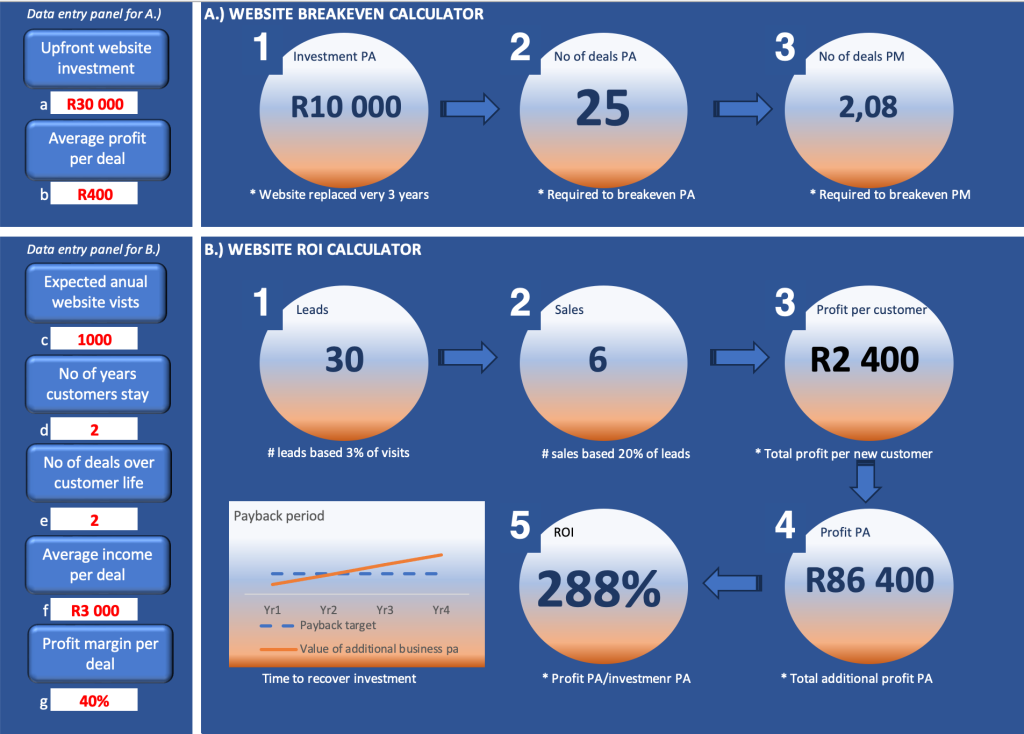Have you ever asked the question: how do I know my website is worth the money paid for it? What is the ROI for a website? How do you do you calculate website ROI?
Are you looking to maximize your website’s return on investment (ROI)? Look no further! Our easy to use calculator guide is here to help you make the most out of your website and drive better results. Whether you are a small business owner, a marketer, or an entrepreneur, understanding the true value of your website is essential for making strategic decisions.
How to calculate your website ROI with our easy to use calculator
With our easy to use guide, you’ll have access to the tools and knowledge needed to calculate your website’s ROI accurately.
Why guess when you can measure? By harnessing the power of data and analytics, you can optimize your website, fine-tune your marketing strategies, and achieve greater success. Don’t let your website’s potential go untapped – unlock its full ROI with our ultimate calculator guide. Get ready to take your online presence to the next level and enjoy higher returns on your investment.
Understanding website ROI calculations
Before we dive into the specifics of calculating your website’s ROI, let’s first define what we mean by ROI. ROI is a metric used to measure the profitability of an investment. In the context of websites, ROI refers to the return generated by your website in relation to the resources invested in it. In other words, it’s a way of quantifying the value of your website in terms of revenue, leads, or any other relevant metric.
Calculating website ROI can be challenging, as it involves measuring intangible benefits such as brand awareness and customer engagement. However, by tracking key metrics and setting specific goals, you can gain valuable insights into the success of your website.
Also read about different website requirements here.
Key metrics for measuring website ROI
To accurately measure your website’s ROI, you need to track the right metrics. While the specific metrics will vary depending on your business and goals, some key metrics to consider include:
Conversion rate
Conversion rate refers to the percentage of website visitors who take a desired action, such as making a purchase or filling out a contact form. By tracking your conversion rate, you can gain insights into the effectiveness of your website’s design and content.
Average order value
Average order value (AOV) refers to the average amount of money spent per transaction on your website. By tracking your AOV, you can optimize your pricing strategy and identify opportunities for upselling and cross-selling.
Traffic sources
Understanding where your website traffic is coming from can help you optimize your marketing strategy. By tracking traffic sources, you can identify which channels are driving the most traffic and adjust your marketing efforts accordingly.
Engagement metrics
Engagement metrics, such as website visits, bounce rate and time on page, can help you understand how visitors are interacting with your website. By tracking these metrics, you can identify areas for improvement and optimize your website’s user experience.
Setting goals for your website ROI
To maximize your website’s ROI, you need to set specific, measurable goals. Your goals should align with your overall business objectives and be based on the metrics you’re tracking. For example, if your goal is to increase revenue, you may set a goal to increase your conversion rate by a certain percentage.
When setting goals, it’s important to be realistic and consider factors such as seasonality and market trends. You should also establish a timeline for achieving your goals and regularly assess your progress.
How to calculate website ROI
Calculating your website’s ROI involves comparing the resources invested in your website to the return generated from it. The formula for calculating website ROI is:
(Revenue generated – Cost of investment) / Cost of investment x 100
To calculate revenue generated, you’ll need to track the relevant metrics, such as sales or leads. The cost of investment includes both the direct costs, such as website design and development, and the indirect costs, such as marketing and maintenance.
By calculating your website’s ROI, you can gain valuable insights into the effectiveness of your online presence and identify areas for improvement.
Website ROI calculator example
The following static image is just an example of a calculation. The panels on the left are used to enter your own values which will the updated the values on the right. The downloadable spreadsheet at the end of the this article can be used to enter and calculate your own values. They are based on general industry rules of thumb.
Dashboard

Instructions to calculate website ROI and breakeven point
- Data entry for panel A.) Breakeven calculation
- Enter upfront website investment in field a.
- Enter average profit per deal in field b.
- Data entry for panel B.) ROI calculation
- Enter expected number of website visits in field c.
- Enter the number of years customers remain customers in field d.
- Enter the number of sales to a customer over their lifetime in field e.
- Enter the average sales value in field f.
- Enter the profit margin per deal in field g.
Results
The breakeven panel will automatically update to yield 3 values in the 3 bubbles.
- The upfront investment divided over 3 years which is the average lifespan of a website.
- The number of deals needed per annum to recover the annual investment.
- The number of deals needed in 2. above per month.
The ROI panel will automatically update to yield 5 values in 5 bubbles and a breakeven (payback) graph.
- Number of leads based on 3% of website visits per annum.
- Number of sales/deals based on 20% of leads per annum.
- The total profit over the lifespan of a new customer.
- The total profit over the lifespan of new customers acquired during a year.
- The annual ROI of the website based on the 4. above and the annual investment of the website.
- Breakeven graph showing when payback will be achieved.
Down load your free website ROI calculator here:
It should also be borne in mind that websites offer a lot more, indirect, benefits than just the ROI calculations above.
Tips for maximizing website ROI
To maximize your website’s ROI, consider implementing the following tips:
Focus on user experience
A positive user experience can increase engagement and conversion rates. Ensure that your website is easy to navigate, loads quickly, and provides value to your visitors.
Optimize for search engines
Search engine optimization (SEO) can help drive more traffic to your website and improve your search engine rankings. Optimize your website’s content and structure for relevant keywords and provide high-quality, informative content.
Use A/B testing
A/B testing can help you identify which website elements are most effective at driving conversions. Test different variations of your website’s design and content to identify the optimal approach.
Leverage social media
Social media can help drive traffic to your website and increase brand awareness. Choose the platforms that are most relevant to your audience and regularly share valuable content.
The importance of website optimization
Website optimization is a critical component of maximizing your website’s ROI. By optimizing your website, you can improve its user experience, increase its visibility, and drive more conversions.
Website optimization involves both on-page and off-page techniques. On-page optimization includes elements such as website design, content, and user experience, while off-page optimization includes techniques such as link building and social media marketing.
By implementing a comprehensive optimization strategy, you can improve your website’s performance and achieve greater success.
Using A/B testing to improve website ROI
A/B testing is a powerful tool for improving your website’s ROI. A/B testing involves testing different variations of your website’s design and content to identify which elements are most effective at driving conversions.
To conduct an A/B test, you’ll need to create two or more versions of your website and randomly direct traffic to each version. By tracking the results of each version, you can identify the most effective design and content elements.
A/B testing can be used to test a variety of website elements, including headlines, calls to action, and images. By regularly conducting A/B tests, you can continually optimize your website and improve its ROI.
Tracking and analyzing website data
To maximize your website’s ROI, you need to regularly track and analyze your website data. By tracking key metrics such as conversion rate and traffic sources, you can gain valuable insights into your website’s performance.
There are a variety of tools available for tracking website data, including Google Analytics. By regularly reviewing your website data, you can identify areas for improvement and make data-driven decisions.
Conclusion: Taking action to maximize your website’s ROI
By understanding how to calculate and optimize your website’s ROI, you can unlock its full potential and achieve greater success. By tracking key metrics, setting specific goals, and regularly optimizing your website, you can improve its user experience, increase its visibility, and drive more conversions.
Don’t let your website’s potential go untapped – take action today to maximize its ROI. With the help of our ultimate calculator guide, you’ll have the tools and knowledge needed to achieve your online goals and drive better results.
For a fuller discussion on what websites can do for you please make contact here.

